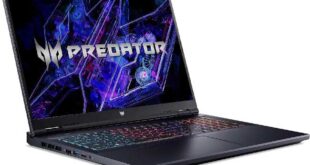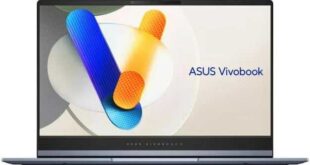At the CES 2022 event, Asus has officially launched a new ‘super product’ called the Asus ROG Flow Z13 2022. It is the first 2 in 1 gaming laptop in the market with a unique design that is both a laptop and a tablet. Not only this, but the new Asus ROG gaming laptop also comes equipped with the latest 12th generation Intel chip and NVIDIA GeForce RTX series graphics card in a very powerful configuration. So what’s interesting about the new Asus ROG laptop? Let’s find out through the Asus ROG Flow Z13 review below!
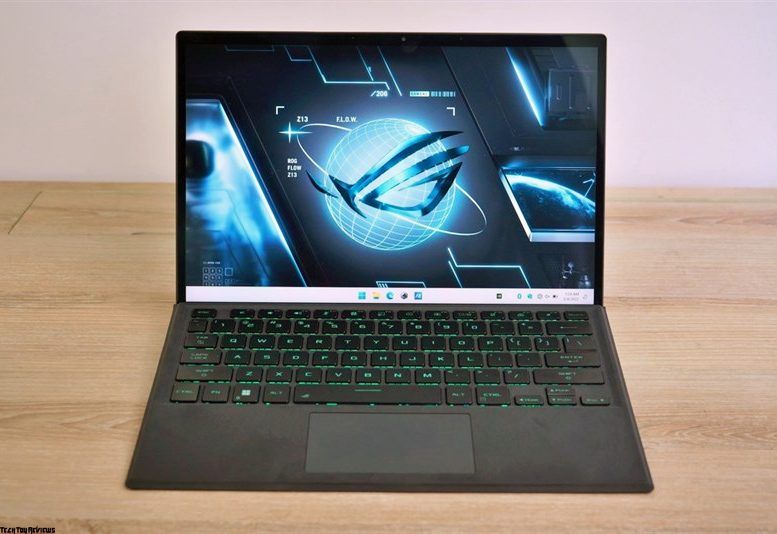
Asus describes the new ROG Flow Z13 2022 as the most powerful ROG tablet for gaming on the market and a look at the specs supports this statement. A brand new Intel Alder Lake Core i9 CPU and the dedicated Nvidia GeForce RTX 3050 Ti and 16 GB of LPDDR5-5200 RAM work in our Asus ROG Flow Z13 review unit. In order to be able to use the performance of the components intelligently, the manufacturer installs vapor chamber cooling and liquid metal for better heat transfer in the processor. There is also a 13.4-inch 16:10 display with 1,920 x 1,200 pixels, 120 Hz, and G-Sync.
Optionally, there are other models with i7 or i5 CPUs as well as the normal RTX 3050 or just the integrated Xe graphics of the Alder Lake processor. This configuration with the iGPU could be interesting if you don’t want to play on the go but want to use the external XG Mobile eGPU (Nvidia GeForce RTX 3080 or AMD Radeon RX 6850M XT) at home. Our Asus ROG Flow Z13 review unit is available for around $2,200. There aren’t many direct competitors for the Asus Flow Z13, which is why we also use normal laptops with comparable components as comparison devices.
Design
In theory, the ROG Flow Z13 is a generic convertible with an integrated kickstand and attachable keyboard, just as we’ve known for years with Microsoft’s Surface Pro, for example. However, the Asus Z13 Flow is significantly more spacious and bulky as well. Due to the high weight, the Asus gaming tablet also looks very valuable, and both the stability and processing of the aluminum case support this impression. The integrated kickstand, which allows for a maximum opening angle of up to 170 degrees, makes a high-quality impact. The material is thin, but it doesn’t bend when you change the angle. The two hinges are very well adjusted, and there is only minimal play. Both the volume rocker and power button (including the fingerprint scanner) are neatly integrated into the case.
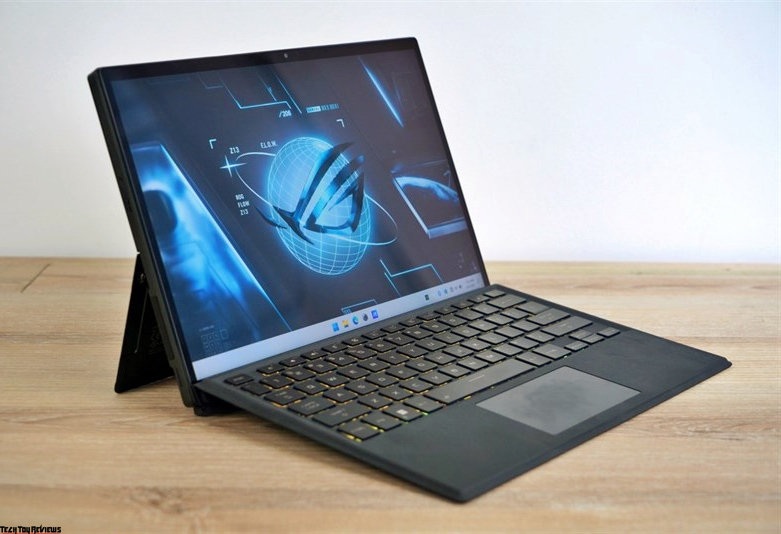
The aggressive design is suitable for ROG tablet and laptop models for gaming. The case also has a small window at the back, which can be illuminated and supports Aura Sync technology (like keyboard lights). However, it also creates a small dent, which is why the tablet can’t lay flat on its back and wobbles. The rear-mounted fan grille is also used as a design element and is hardly noticeable. There is a huge Republic of Gamers at the top surrounded by two vents.
The included keyboard case also acts as a cover and protects the display when not in use. The back of the keyboard case has a kind of velour cover, which feels comfortable and provides good support, but also tends to collect dust and dirt very quickly.
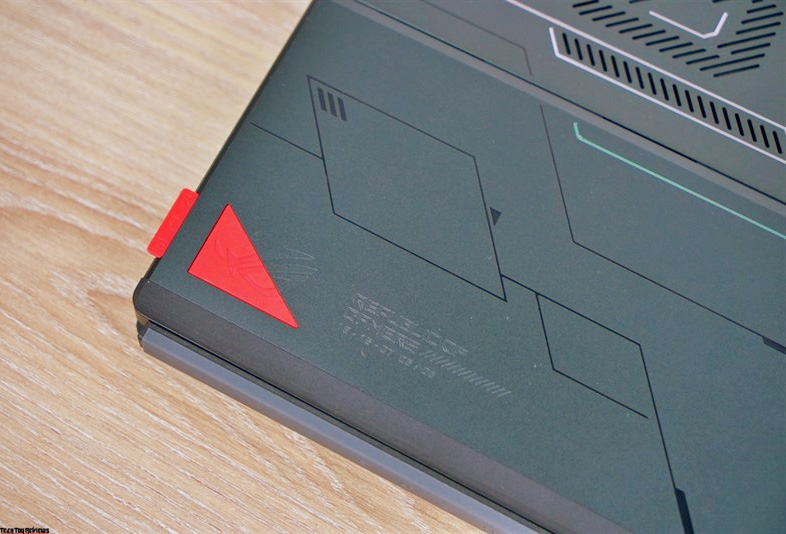
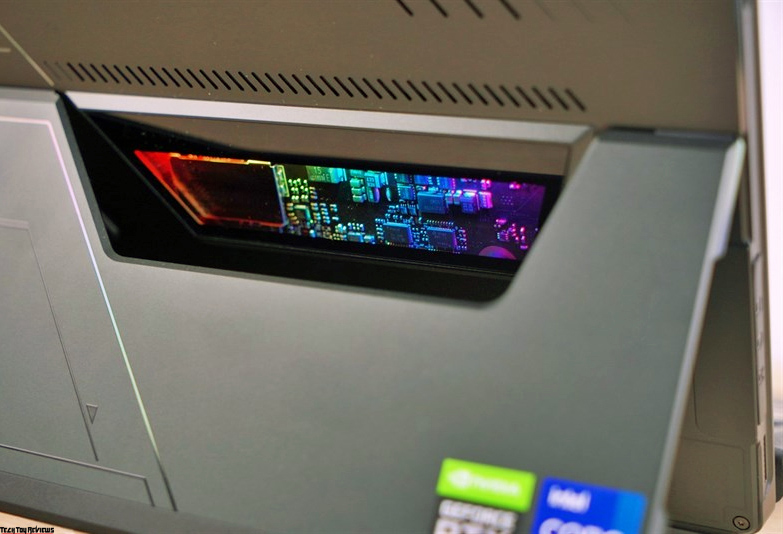
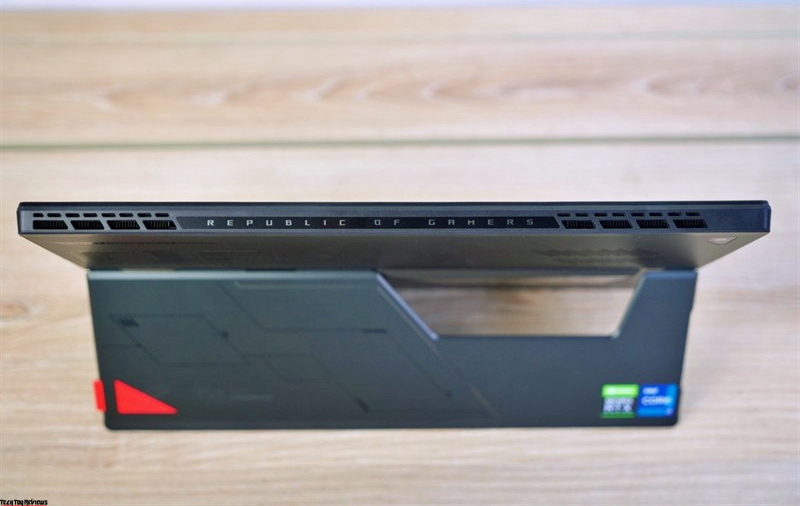
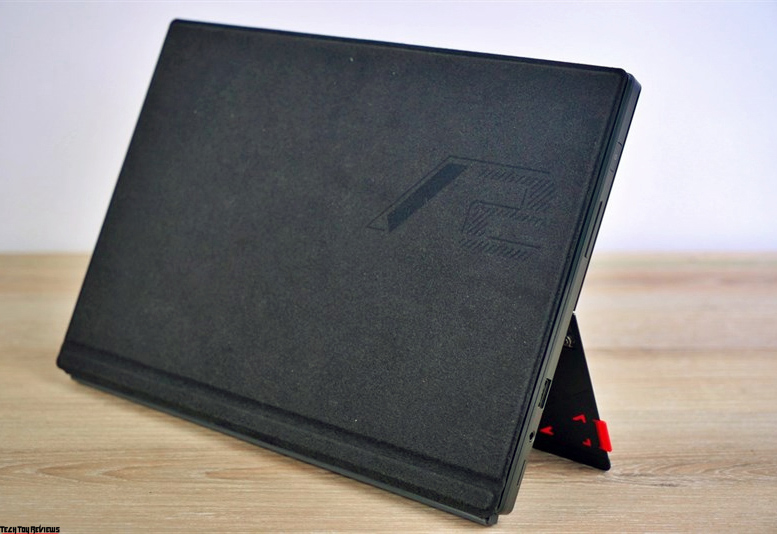
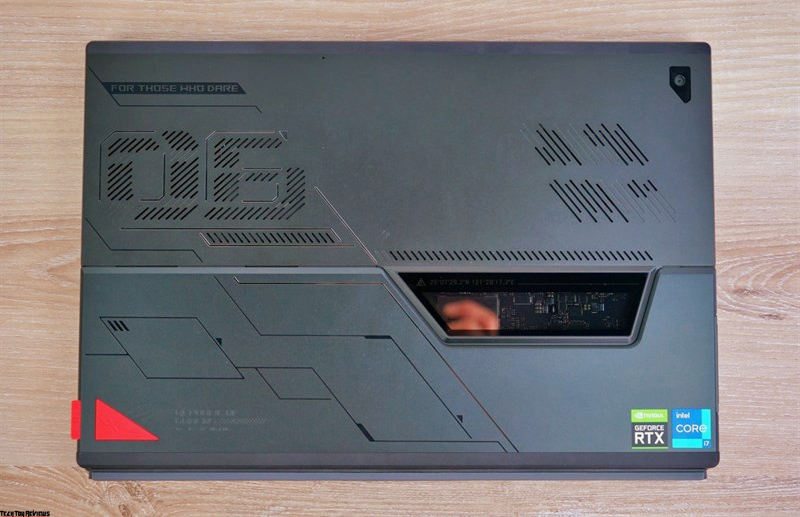
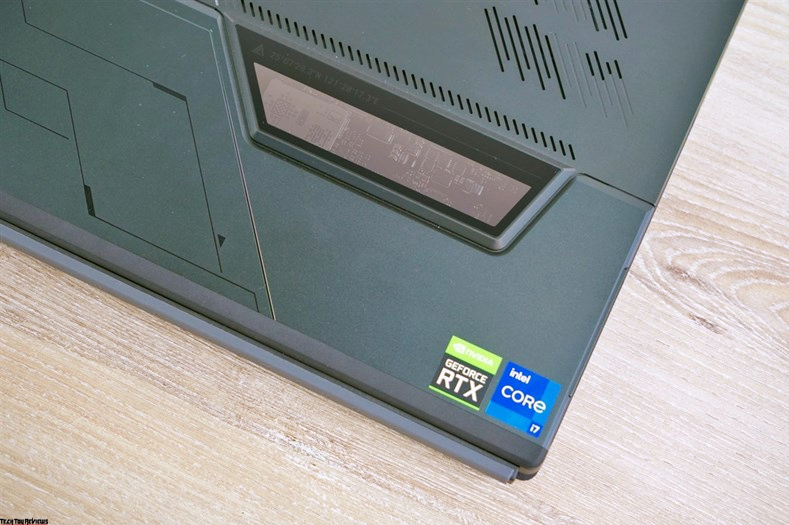
The weight of Asus ROG Flow Z13 alone is 1.185 kg. It gains a little over 1.5kg with the keyboard case, and the package is also about 2cm thick. It’s still very portable, and the 100-watt power adapter weighs in at a little over 400 grams.
Connectivity and Ports
Asus installs a cutting-edge Wi-Fi 6E module from Intel (AX210E), which supports all modern standards including Bluetooth 5.2. Wi-Fi 6E, so it’s well-equipped for the next few years. The transfer rates in connection with our reference router (Netgear AX12) were good, and we did not detect any problems with the signal quality on our Asus ROG Flow Z13 review unit or with the Wi-Fi 6 router. However, an integrated LTE or 5G modem is not offered.
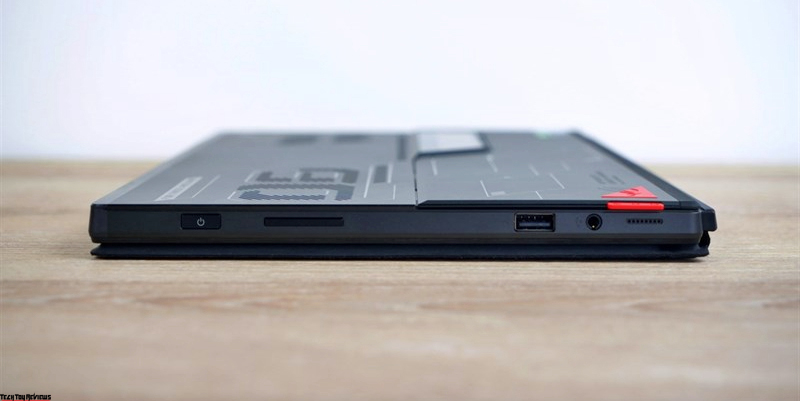
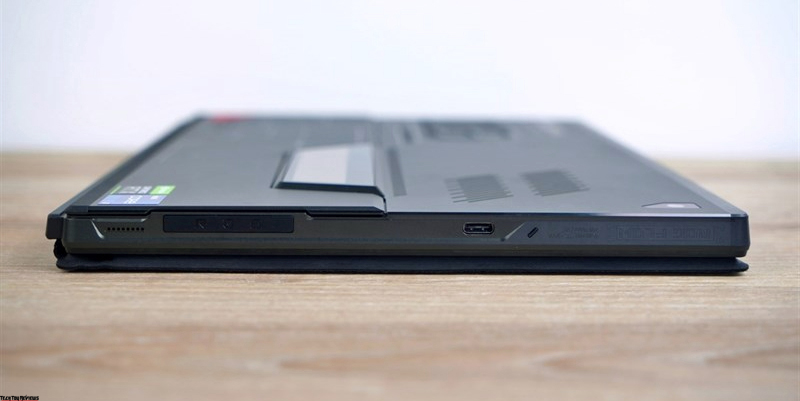
The available ports are by no means bad for a tablet, as on the left side there is a USB-C port with Thunderbolt 4 support as well as the connection for the external graphics card behind a small cover made from a USB-C connection and a proprietary connection with 8 PCIe lanes. There is also a regular USB-A port on the right, but this only supports the outdated USB 2.0 standard, which is a bit incomprehensible.
There is a small microSD card reader on the back behind the kickstand that fully accepts the memory card. The card reader works very quickly, and we were able to determine a very high maximum transfer rate of more than 260 MB/s. This puts Asus ROG Z13 Flow clearly at the top of the comparison field. The performance was a bit slower when copying data, but the result is still decent at more than 100 MB/s.
Keyboard
The ROG Flow Z13 comes with a keyboard cover that attaches magnetically to the bottom of the tablet and is also powered via the pogo pins. As with the Surface Pro, the keyboard can be used either flat or slightly angled. The problem with this is that the material senses the angle and the keyboard then lift off the floor a bit and gives way when typing, for example, when you want to use it flat on a table again. This affects input stability somewhat, which is the norm for keyboard covers of this type.
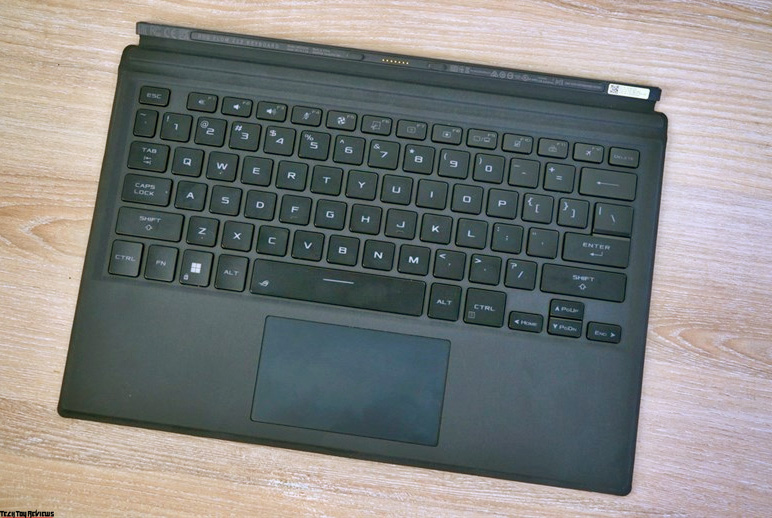
However, the mechanism of the keys themselves is decent. The key travel isn’t too short either (1.7 mm), and several keystrokes are registered at the same time (N-Key rollover). In practice, however, you almost always have to work with the keyboard backlight activated (RGB, one zone, supports Aura Sync), since the contrast between the dark keys and the lettering is simply not optimal.
The small TouchPad (9.8 x 5.6 cm) offers good gliding traits, and mouse control is also possible without any problems, but the small area is not particularly suitable for gestures. The pad can also be pressed down in the lower area, but this is acknowledged with a loud and cheap-looking clicking noise. However, we assume that most users will use an external mouse anyway, especially when gaming. In addition, the capacitive touchscreen is also available in everyday use and works very well.
Display
Asus offers two different 13.4-inch IPS touchscreens in a 16:10 aspect ratio for the ROG Flow Z13. In addition to a 4K display (3840×2400 pixels, WQUXGA, 60 Hz, 450 nits, P3 color space), there is also the FHD panel with 1920×1200 pixels, WUXGA), which only covers the smaller sRGB color space, but it does slightly brighter (500 nits) and offers a higher 120Hz refresh rate. The FHD resolution also suits the RTX 3050 Ti better, so overall we think the FHD panel is apt for the gaming tablet.
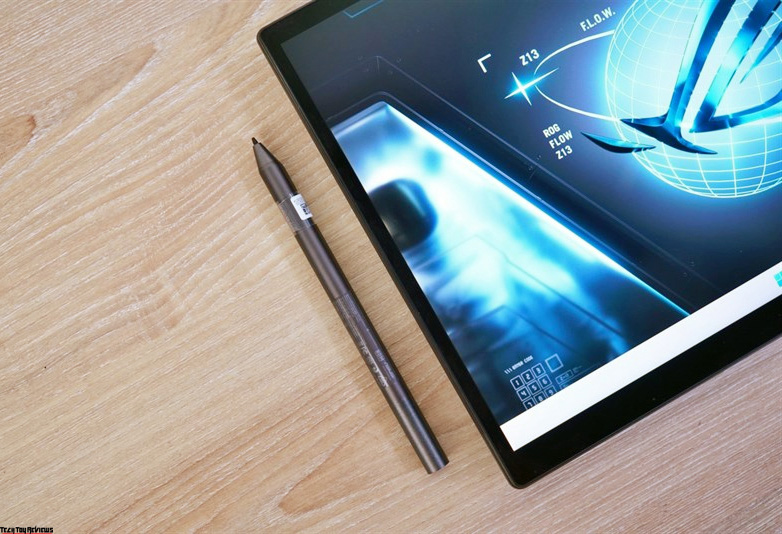
The subjective image impression is nice, and all content looks very sharp, even with the lower Full HD resolution. The colors also appear strong and rich in contrast, which is also confirmed by our measurements. The maximum brightness is 515 cd/m² in the center of the screen, but it is 476 cd/m² on average. The black value is slightly higher at 0.35 cd/m², but this still results in a good contrast ratio of almost 1500:1. Response times are unobtrusive, and halos aren’t a problem even at full brightness.
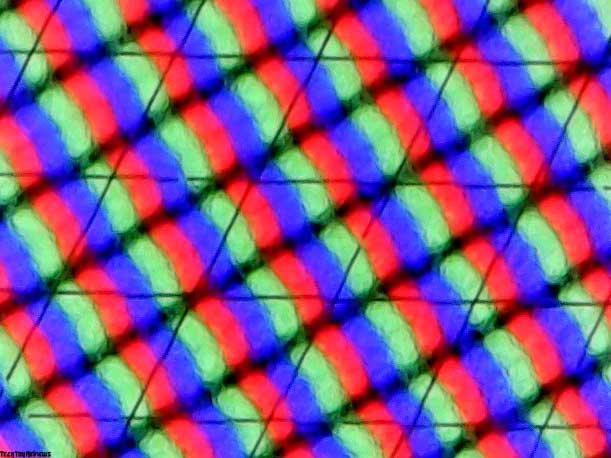
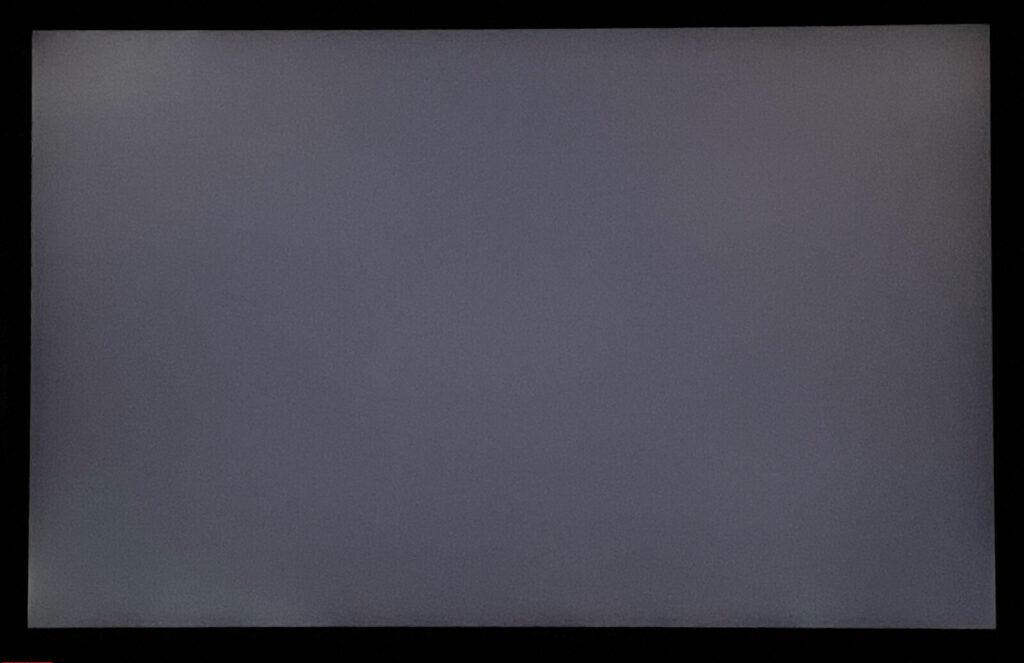
The screen refresh rate defaults to 120 Hz on AC power, but automatically switches to 60 Hz on battery power. When plugging in or unplugging the power adapter, the screen goes black for about a second. This behavior can be changed in the Armory Crate software because there is an “Energy-saving panel” item here. As soon as you deactivate it, the frequency stays at 120 Hz even in battery mode. In everyday life, the 120 Hz mode primarily leads to a smoother picture impression when scrolling through documents or websites, and it can also be an advantage when playing games.
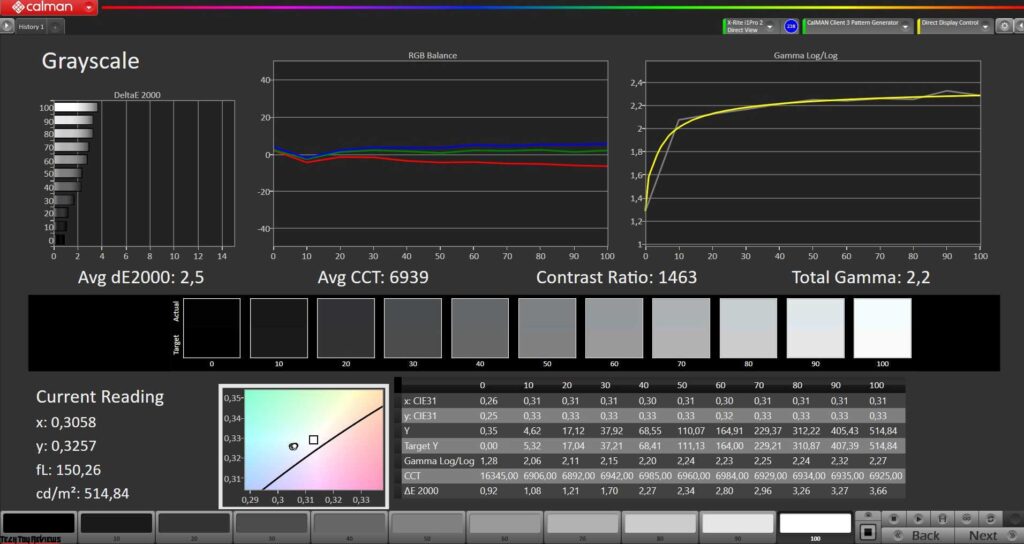
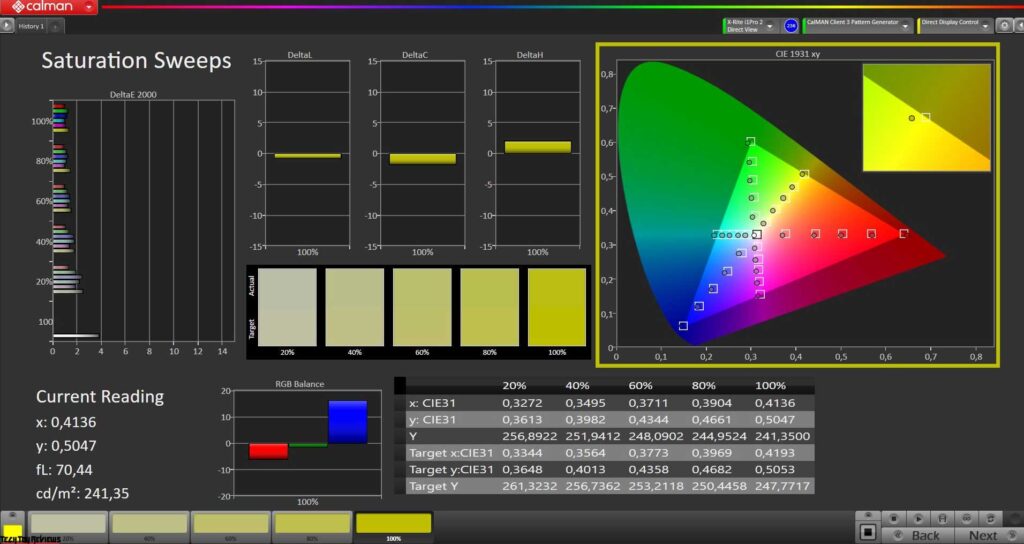
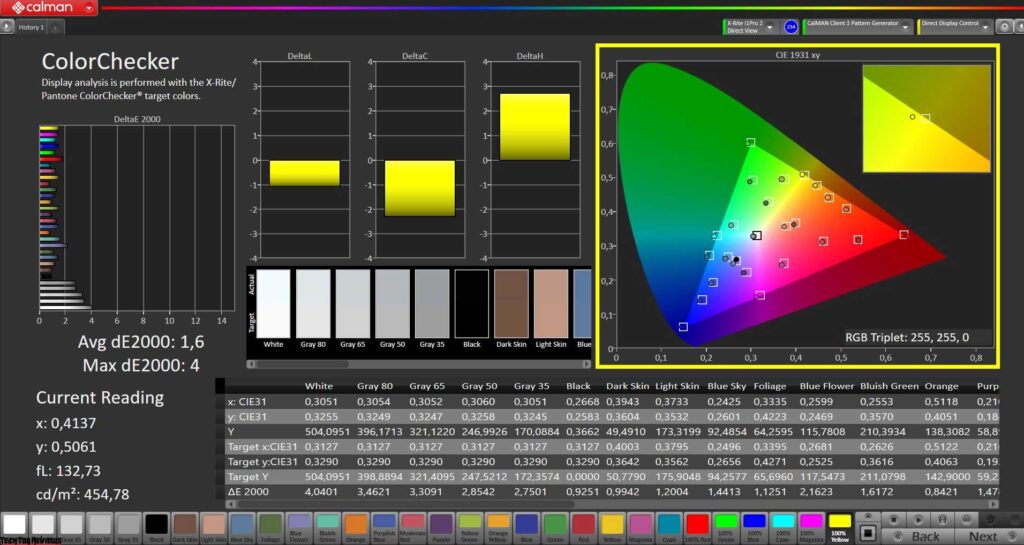
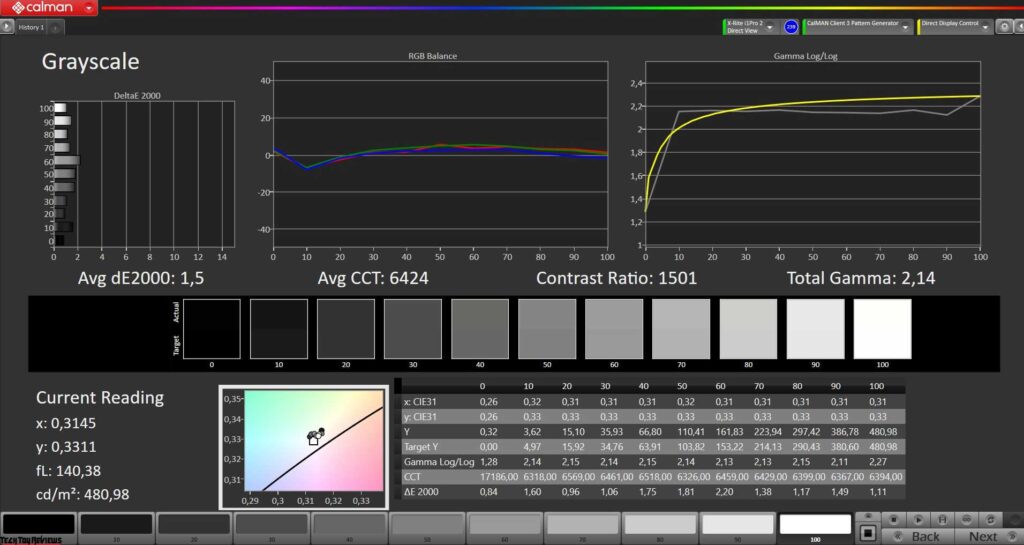

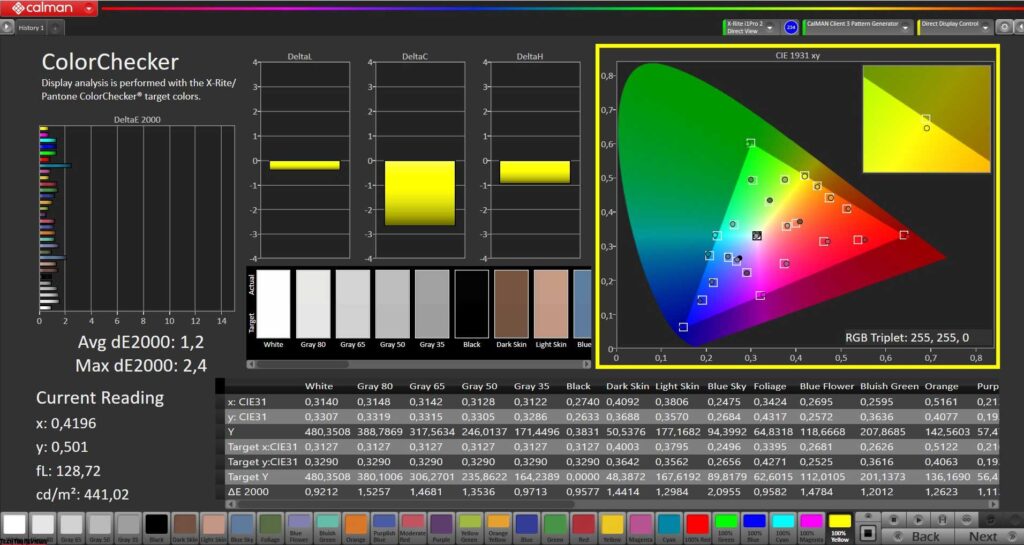
We analyzed the display using the professional CalMAN software and the X-Rite i1 Pro 2 spectrophotometer. In the factory state, we see a slight color cast in the direction of green/blue in the grayscale in connection with a color temperature that is a bit too cool. That doesn’t play a major role in everyday use, and you can only see it with the naked eye if you otherwise work with calibrated displays. Manufacturers like to use this trick to slightly increase the maximum brightness. Since both the deviations in the colors and the grayscale are already very good out of the box, calibration is not necessary.
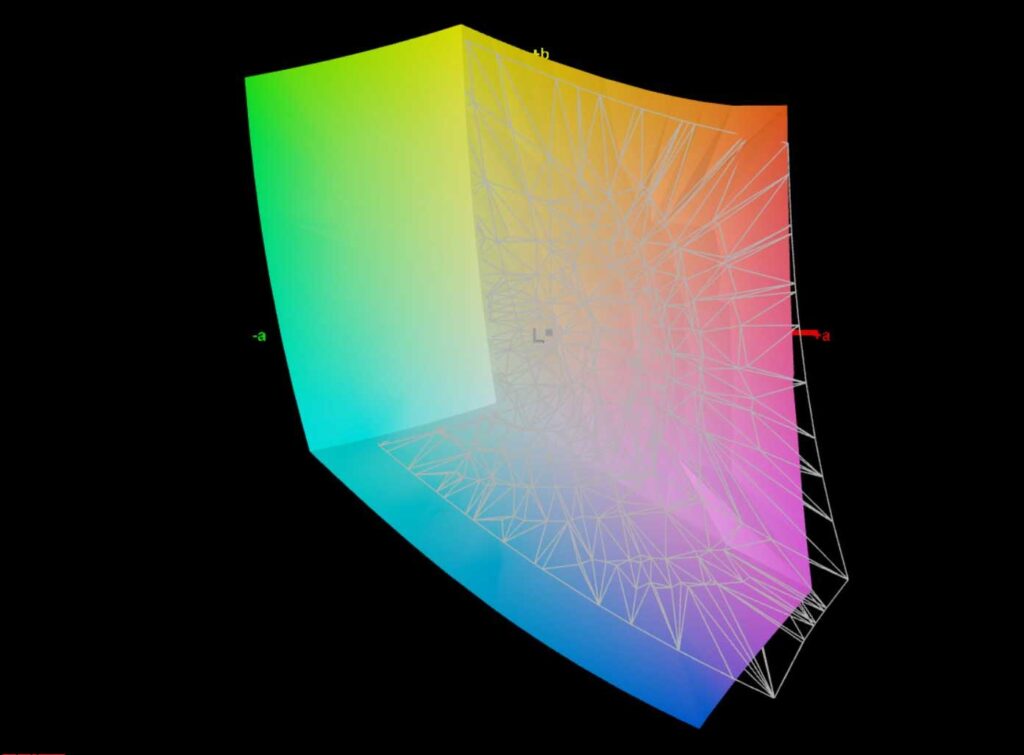
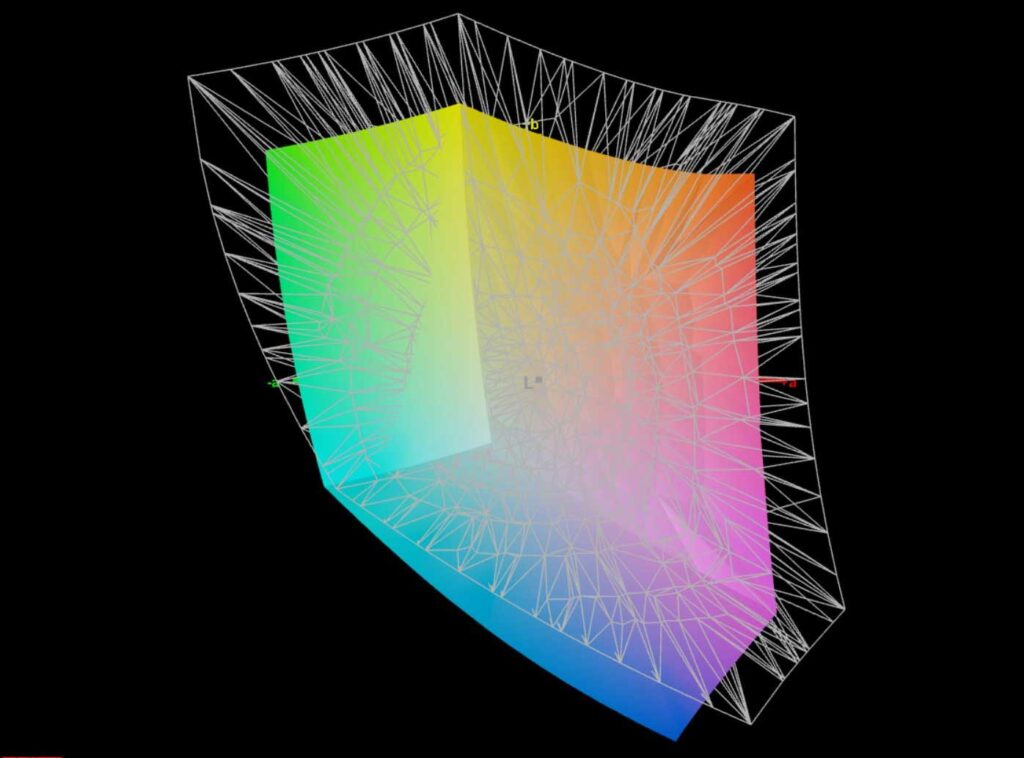
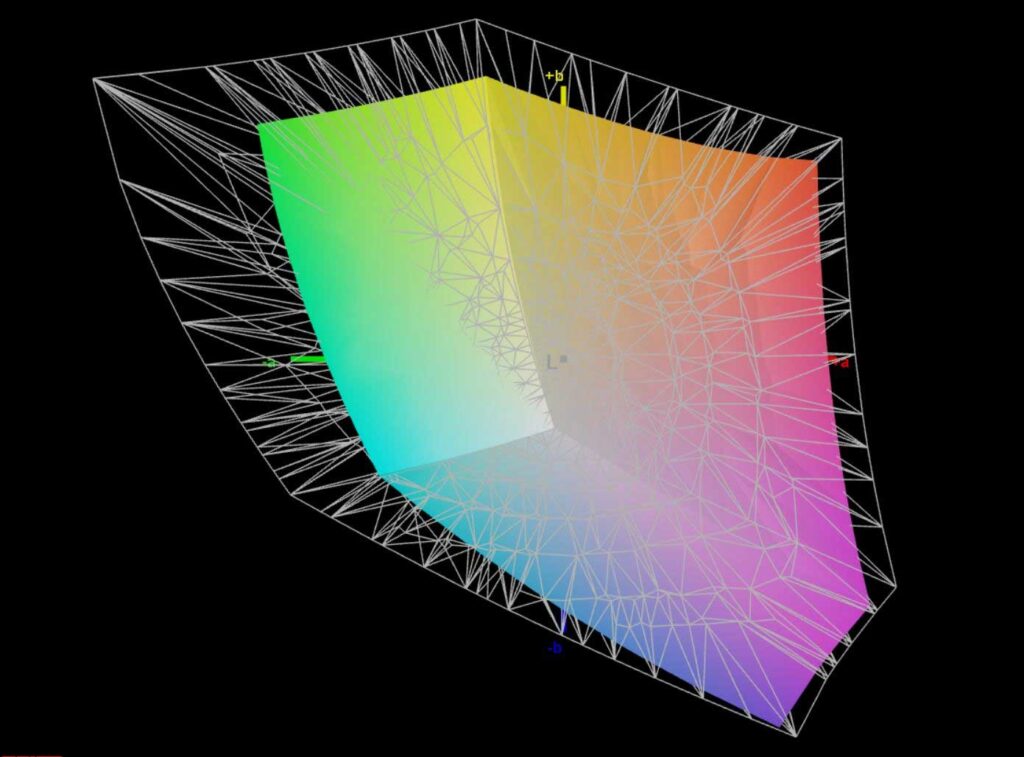
The brightness is very high and not reduced in battery mode, but reflections quickly appear on the reflective touchscreen. The visibility of content is therefore limited, especially in very bright surroundings. However, it should be possible to work comfortably in the shade or on cloudy days if the device is aligned appropriately. The IPS panel offers stable viewing angles without color shifts or contrast losses.
Asus ROG Flow Z13 specifications
- Display: 13.40-inch IPS panel, 16:10, 1920 x 1200 pixel, 169 PPI, detachable touchscreen, HDR, 120 Hz
- CPU: Intel Core i9-12900H 14 x 1.8 – 5 GHz, 114 W PL2 / Short Burst, 55 W PL1 / Sustained, Alder Lake-P
- GPU: NVIDIA GeForce RTX 3050 Ti Laptop GPU – 4096MB, Core Clock: 1297MHz, Memory Clock: 1375MHz, 40W TDP (includes 5W Dynamic Boost), GDDR6, 511.79, Optimus
- Motherboard: Intel Alder Lake-P PCH
- Memory: 16GB LPDDR5-5200, dual channel, onboard
- Storage: Micron 2450 1TB NVMe SSD, 875 GB available
- Sound card: Intel Alder Lake-P PCH – cAVS (Audio, Voice, Speech)
- Ports: 1x USB 2.0, 1x USB 3.1 Gen2, 1x USB 4.0 40 Gbps, 1x Thunderbolt, USB-C Power Delivery (PD), 2zc DisplayPort, 1x 3.5 mm stereo, 1x microSD card reader
- Sensors: Fingerprint reader, Brightness sensor
- Connectivity: Intel Wi-Fi 6E AX210 (a/b/g/h/n = Wi-Fi 4/ac = Wi-Fi 5/ax = Wi-Fi 6), Bluetooth 5.2
- Battery: 56Wh Lithium Polymer
- OS: Windows 11 Home
- Camera: Front camera: 0.9 MP, Rear camera: 8 MP
- Features: Stereo speakers, Chiclet Keyboard with Light, 100W PSU
- Dimensions: 12 x 302 x 204 mm
- Weight: 1,185 kg, AC adapter: 407 g
Asus ROG Flow Z13 Review
Performance
Our Asus ROG Flow Z13 review unit configuration is the most powerful in the series and relies on the new Alder Lake Core i9-12900H in conjunction with the dedicated GeForce RTX 3050 Ti, which is operated with a maximum of 40 watts (35W + 5W Dynamic Boost from the processor). The 2 in 1 gaming laptop is rounded off by 16 GB of LPDDR5-5200 RAM (dual channel), and there are currently no models with 32 GB of RAM.
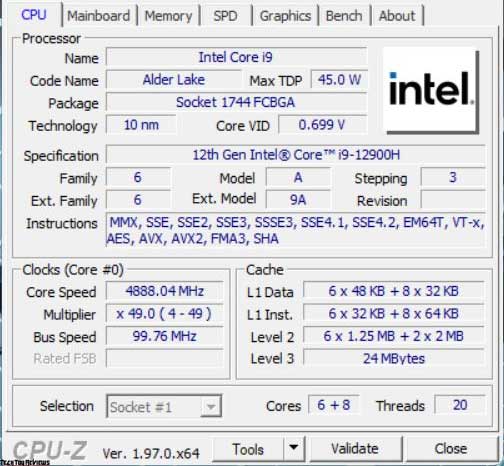
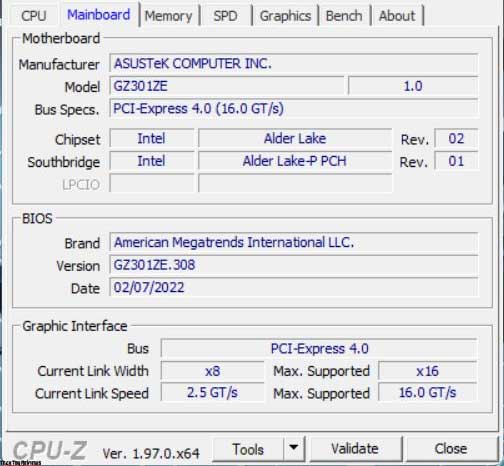
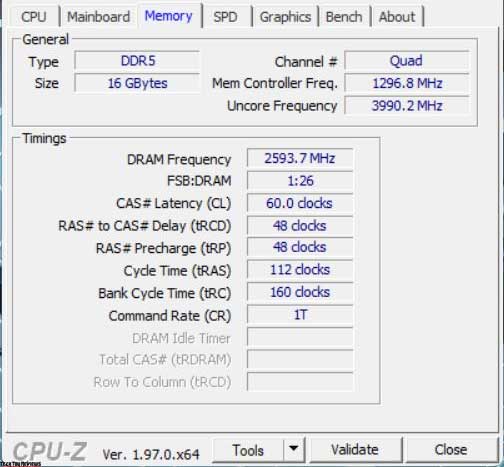
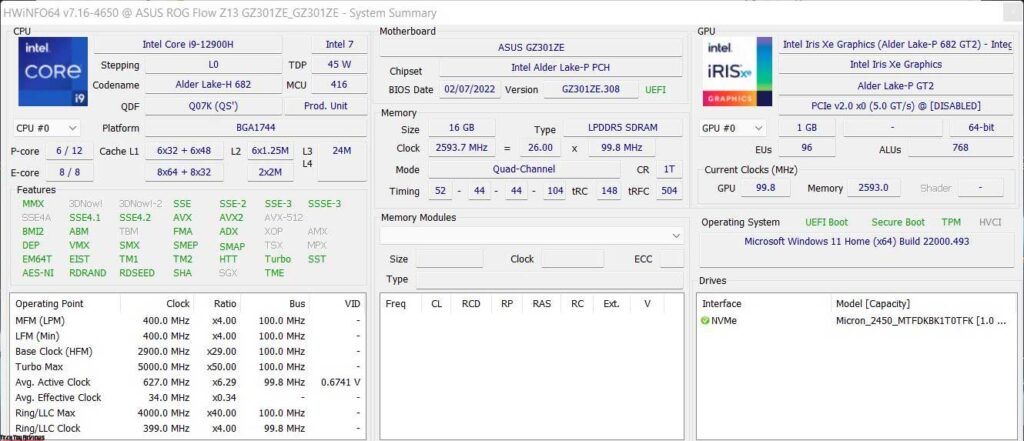
Putting such a powerful Core i9 CPU in a compact gaming tablet doesn’t necessarily make much sense to us, especially in combination with the slowest variant of the RTX 3050 Ti. There is certainly a slight imbalance here, and the Core i7 CPU will probably not work noticeably slower in the ROG Flow Z13 (same number of cores, but lower turbo frequency).
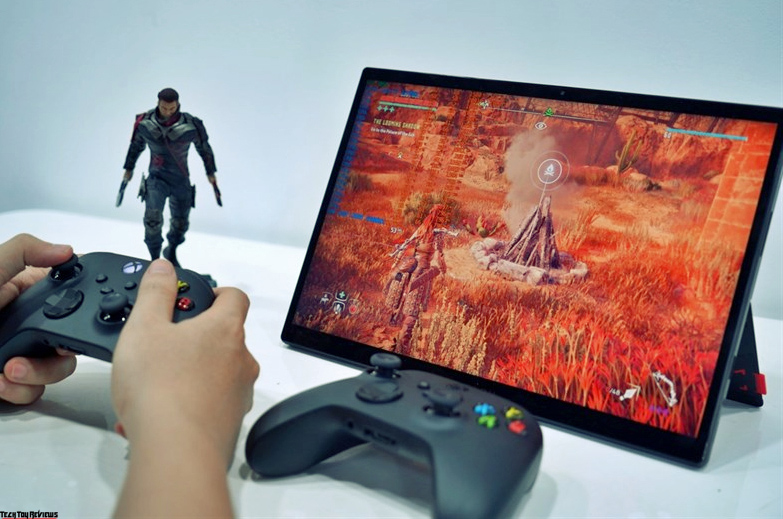
The new Core i9-12900Hfrom Intel’s Alder Lake lineup (12th generation) is one of the fastest mobile chips currently on the market and offers a total of 14 cores (6 performance cores with Hyper-Threading and 8 efficiency cores) with 20 threads as well a maximum clock of up to 5.0 GHz. Such a CPU is more likely to be found in high-end gaming laptops and certainly not in a compact gaming tablet. The nominal TDP is still 45 watts, but Asus hasn’t limited the consumption in practice, and we see consumption of up to 114 watts in the first 30 seconds in multi-core tests, after which the consumption levels off at 55 watts on. The ROG Flow Z13 thus offers excellent performance, especially with short load peaks (and also many benchmarks), but the tablet always uses the internal battery for a short time.
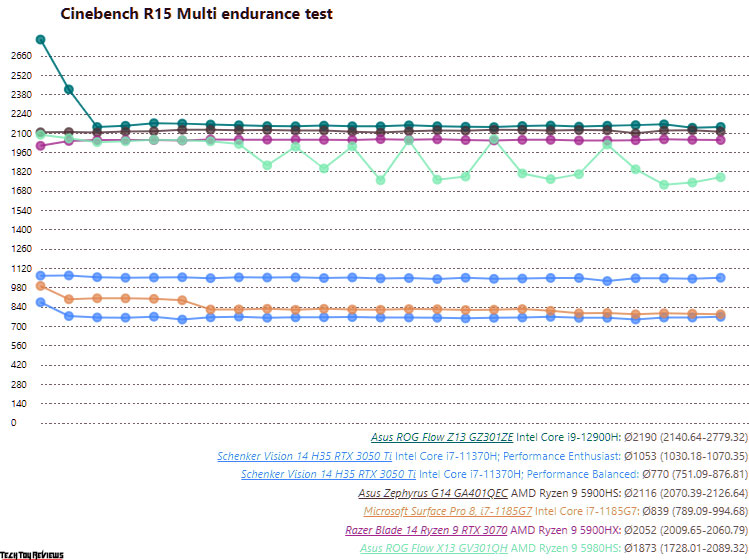
The Asus ROG Flow Z13 review unit is at the top of the comparison field in the CPU benchmarks. In the Cinebench loop, you can clearly see that the power consumption has already stabilized at 55 watts in the third run, so the performance is more than 20 percent lower than in the first run. Nevertheless, the Intel chip is also competitive with 55 watts and operates on the level of the current Ryzen 9 5000 chips in the Asus Zephyrus G14 or the Razer Blade 14, which are operated there with 75 or 80 watts. The current Tiger Lake H35 chips, which are currently used in many compact laptops, have absolutely no chance with their four cores.
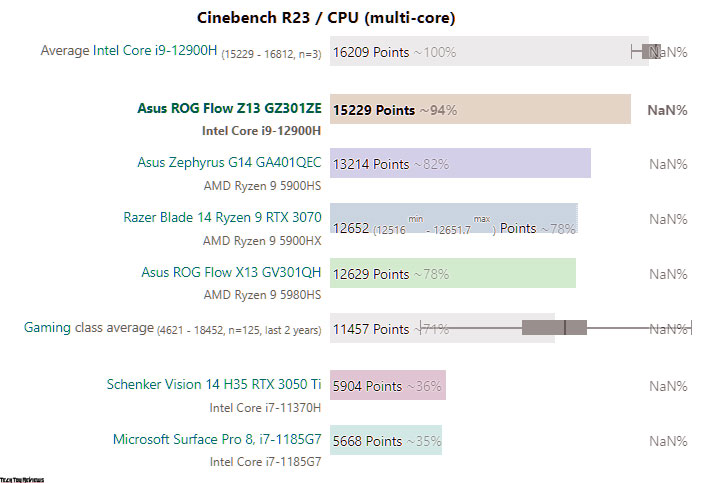

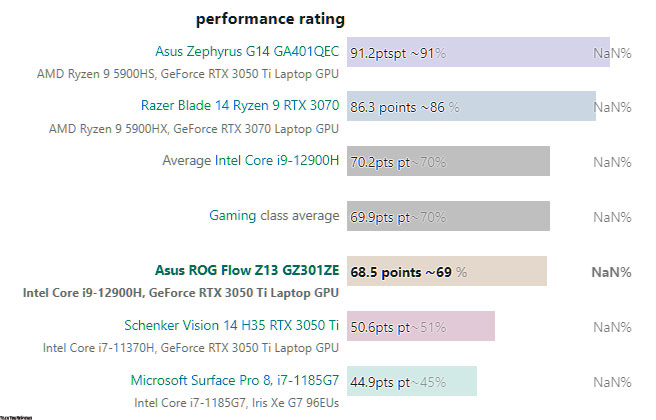
The new Asus ROG tablet has a powerful system and this is also confirmed by the good benchmark results. However, we occasionally noticed slight stuttering during our Asus ROG Flow Z13 review, for example when opening the Windows settings. We currently don’t know the reason, but it doesn’t seem to be a problem with the graphics switching. It may have something to do with the Armory Crate software, possibly also with the new hybrid structure of the processor cores. However, the stutters only occurred very rarely, so it is not annoying. Otherwise, the subjective impression of performance is also very good.
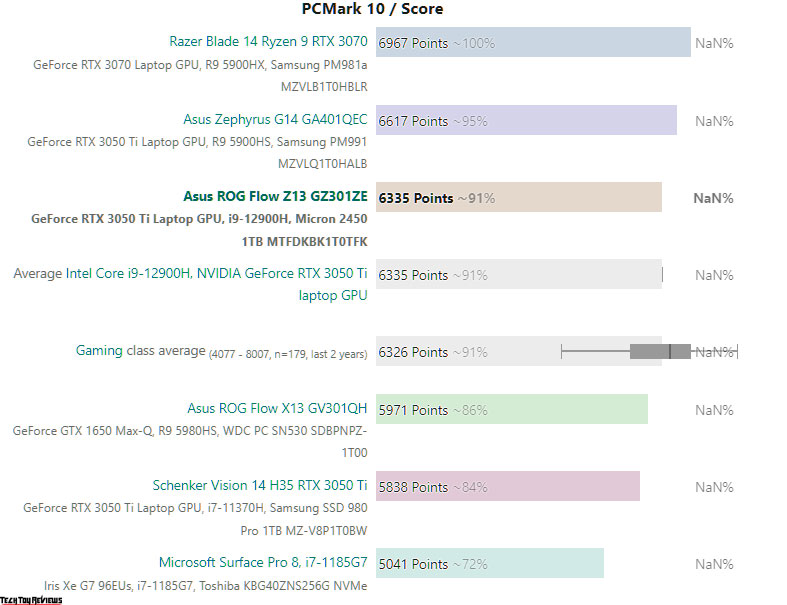
In our standardized latency test (web surfing, YouTube 4K playback, CPU load), the Flow Z13 shows increased latencies. With the current BIOS version, the Asus ROG gaming laptop is only suitable for the use of real-time audio software to a limited extent.
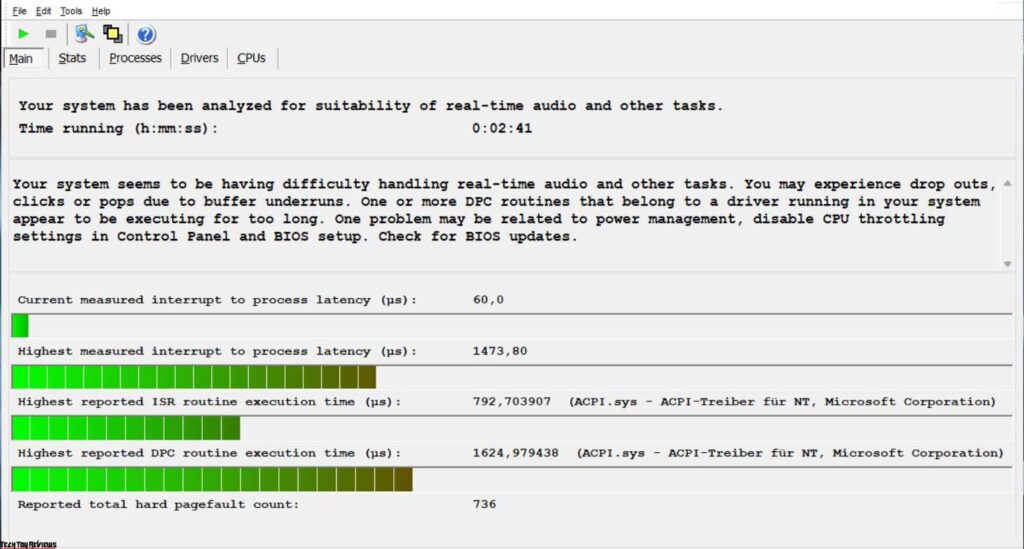
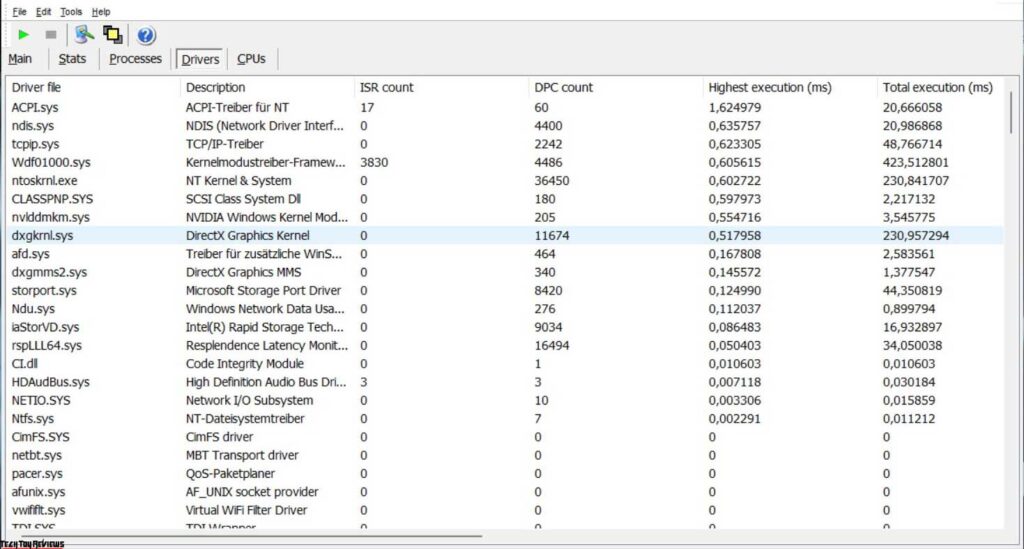
Asus uses a compact M.2 2230 SSD, which is also easy to access via a small hatch on the back. Despite the small size, it is a PCIe 4.0 SSD, which in our Asus ROG Flow Z13 review unit comes from Micron and offers a storage capacity of 1 TB. after the first start-up, 875 GB are still freely available. The benchmark results aren’t bad by any means, and there aren’t any limitations in everyday use or gaming either, but the maximum sequential transfer rates are more in line with fast PCIe 3.0 x4 drives. On the other hand, the Micron SSD delivers good performance in the 4K tests.
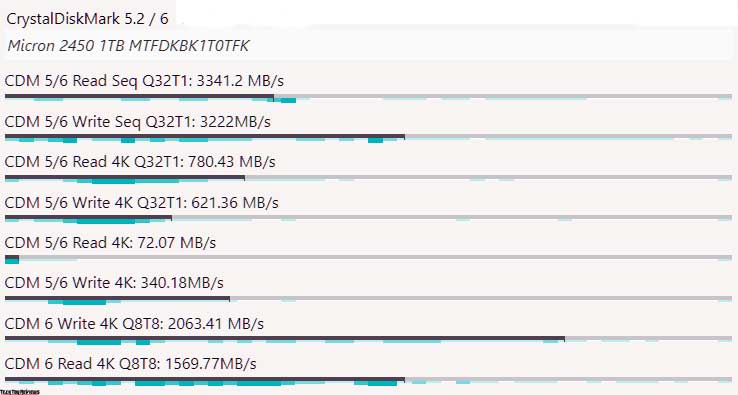
The ROG Flow Z13 2022 comes with a built-in Nvidia GeForce RTX 3050 Ti. When playing games, then automatically switched on via Optimus technology. As we mentioned earlier, this is the slowest version of the RTX 3050 Ti with a TGP of just 35 watts, with Dynamic Boost allowing 5 watts to be used by the processor depending on usage. In the benchmarks, we could observe a maximum core clock of 1,297 MHz, and there is 4 GB of GDDR6 VRAM.
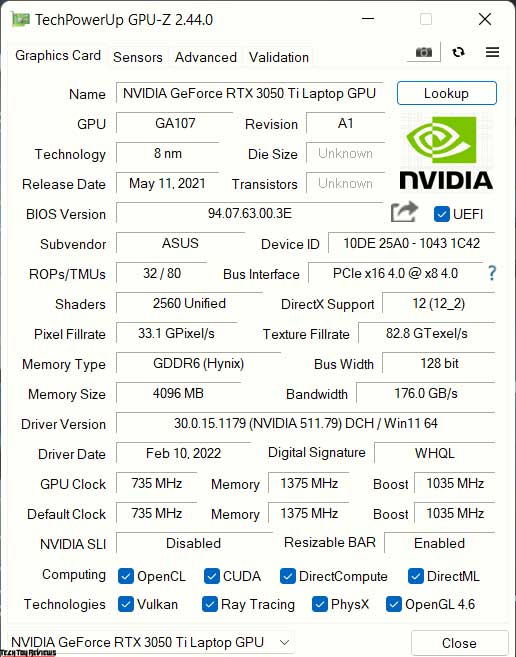
The synthetic benchmarks again show that this is one of the slowest versions of the RTX 3050 Ti. However, the performance remains stable under longer loads, and the 3DMark Time Spy stress test is passed with 97 percent. In battery mode, the power consumption is initially limited to 35 watts, when the battery capacity falls below 50%, it is a maximum of 26 watts.

Thanks to the built-in MUX switch, the integrated graphics card can be deactivated, which can lead to improved latency and higher gaming performance. However, in our Asus ROG Flow Z13 review tests, we could not see a performance advantage in either the synthetic 3DMarks or the gaming tests. You can certainly experiment a bit here, but in general, we would recommend simply leaving the hybrid graphics activated, since Nvidia’s Optimus technology works very well.
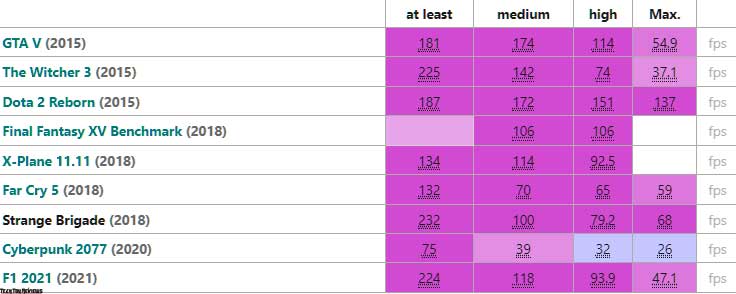
The gaming performance of the RTX 3050 Ti is often only sufficient for current titles for medium details, but at least less demanding or older games can often also be played with high details. In any case, a significant performance gain is possible with the 150-watt version of the mobile GeForce RTX 3080.
Noise emissions
Asus uses a high-quality cooling solution for its gaming tablet and relies on liquid metal for the processor and vapor chamber cooling with two fans. We were pleasantly surprised by the volume in terms of the high performance. In everyday use, the device is usually completely silent and the fans don’t run at all or are simply not audible.
On the other hand, the fans speed up quickly under load. As soon as the graphics card is put under pressure (e.g. when playing games), it quickly rises to 41 dB(A), whereby the noise is in no way disturbing. You can hear it in the background, but you can still play without any problems and use the speakers for the game sound.
After the end of the load, the fan speed is reduced again very quickly (gradually between 31.9 and 29.6 dB(A)) and then quickly becomes silent again. There is no more performance in the optional Turbo mode, but the volume also increases by around 44 dB(A). As we will see shortly, the temperatures are not critical anyway, so the turbo mode is not really useful.
Heatsink
Despite the relatively low background noise, the ROG Flow Z13 doesn’t get particularly warm when gaming, because we can measure a maximum of around 44 °C on the back. Even in the stress test, there is no point where the 50-degree mark is exceeded. Since you will hardly hold the tablet in your hand while playing (demanding games), there are no restrictions here. In addition, the warm air is discharged upwards and is therefore not a nuisance. The case temperatures don’t even reach 30 °C during everyday tasks.
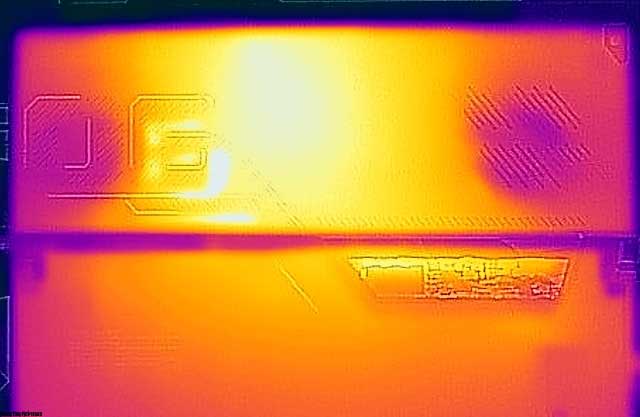
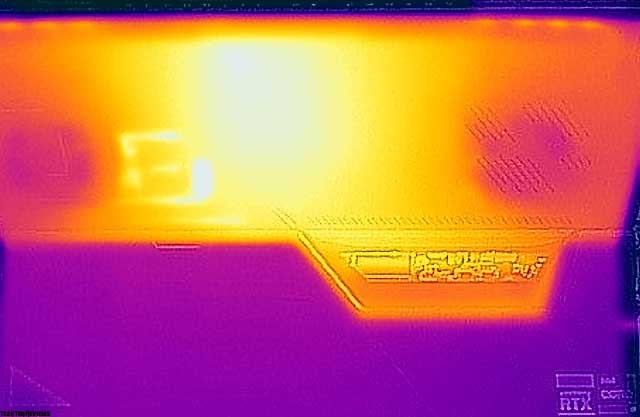
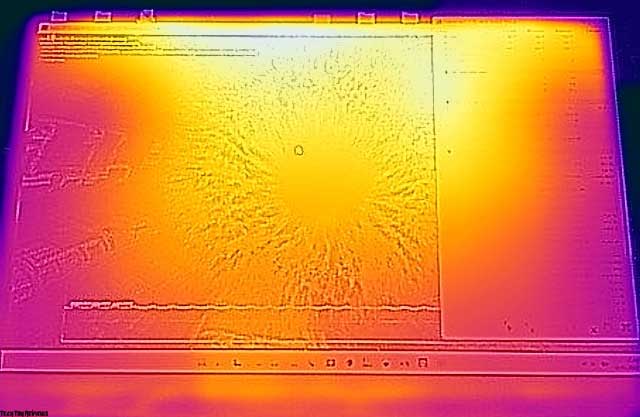
Audio
Asus installs two Smart Amp speakers, which are located in the lower area of both sides and emit the sound to the side. Despite the small width of the case, this creates a slight stereo effect, and overall the speakers offer decent performance, but there is simply a lack of pressure. The microphones also do their job satisfactorily, but most gamers will probably use a headset anyway.
Battery life
The 56 Wh battery does not promise a particularly long battery life. With an adjusted brightness of 150 cd/m² (corresponds to 35% of the maximum brightness in our Asus ROG Flow Z13 review unit), we determine 5.5 to 6 hours in WLAN or video mode. Our Wi-Fi test only runs for a little over 4 hours at maximum brightness. Incidentally, the 120 Hz mode does not affect the runtime in our tests.
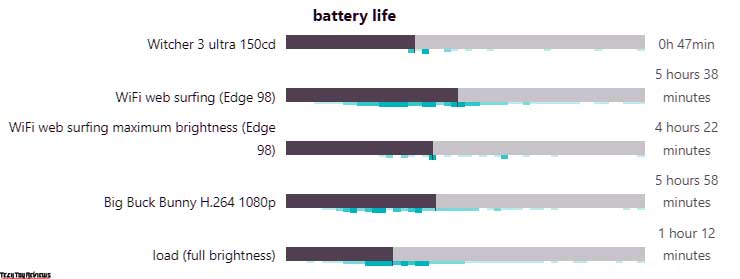
With these results, we wouldn’t recommend the optional 4K panel as it will likely consume even more power. A complete charging process takes around 100 minutes when the device is switched on, but 50% of the capacity is available after just under 28 minutes.
Final line
What the ROG Flow Z13 brings to you from the design, configuration to the optimum capabilities of the device. Although not really suitable for the majority of users, the potential of ROG Flow Z13 is great, and we think this will be one of the trending products in the future! The impression of the 2 in 1 gaming laptop or convertible is positive because, in addition to a fast Alder Lake CPU and stable gaming performance, the cooling is surprisingly effective and quiet.
You can easily use the built-in speakers while gaming. The 1200p display in 16:10 format also convinces with good color reproduction and high brightness. Since the battery life is already not particularly long, we would not recommend the optional 4K panel.
However, there are also some points where there is room for improvement. First off, the CPU/GPU combo is relatively unbalanced, as a high-end i9 CPU is paired with the slowest version of the GeForce RTX 3050 Ti. The Core i9 offers extremely high performance, especially during short peak loads and single-core benchmarks. With the optional XG Mobile eGPU (either with the RTX 3080 or RX 6850M XT), the graphics performance can be increased drastically, and thanks to the good CPU performance, the tablet does not become a bottleneck here either.
Asus ROG Flow Z13 price and availability
Our Asus ROG Flow Z13 review unit with the Core i9 and the RTX 3050 Ti costs $2,199.99 on Amazon.com. While the model with Core i7-12700H, 16GB RAM, 512GB SSD, and NVIDIA GeForce RTX 3050 4GB costs $1,799.99 and is available now on Bhphotovideo.com and Adorama.com online retailers.
 Technology News, Reviews and Buying Guides review, monitor review, tablet review, laptop review, mobile review, smartphone review, buying guide,
Technology News, Reviews and Buying Guides review, monitor review, tablet review, laptop review, mobile review, smartphone review, buying guide,
